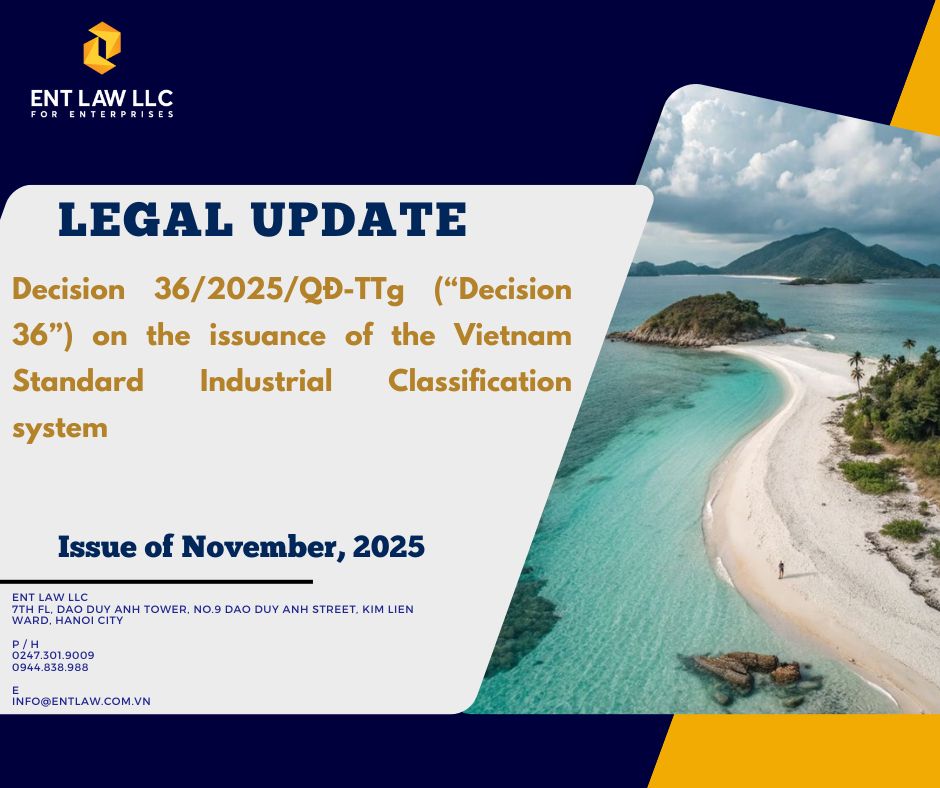Dear Valued Clients,
On September 29, 2025, the Prime Minister promulgated Decision 36/2025/QĐ-TTg (“Decision 36”) on the issuance of the Vietnam Standard Industrial Classification system, which officially takes effect from November 15, 2025. This Decision replaces Decision 27/2018/QĐ-TTg (“Decision 27”) and marks a significant advancement in the standardization, unification, and updating of the national economic sector classification system.
In this Legal Update, we highlight several new industries added under Decision 36 to enable businesses and investors to proactively review, consider, and adjust their business sectors accordingly (if applicable) to ensure compliance with current legal regulations..
As always, we hope you find this article informative and look forward to continuing our cooperation with you in the near future.
1. Clear 5-Level Structure and Expanded Economic Sector Scale
Decision 36 retains the 5-level classification structure but adjusts the number of industry codes to be more detailed and accurate:
| Level | Number of Sectors | Description |
| 1 | 22 | – Defined alphabetically from A to V;
– Increased by 1 business sector code compared to Decision 27. |
| 2 | 87 | – Formed according to corresponding level 1 sectors, each coded with two digits from 01 to 99;
– Decreased by 1 business sector code compared to Decision 27. |
| 3 | 259 | – Formed according to corresponding level 2 sectors, each coded with three digits from 011 to 990;
– Increased by 17 business sector codes compared to Decision 27. |
| 4 | 495 | – Formed according to corresponding level 3 sectors, each coded with four digits from 0111 to 9900;
– Increased by 9 business sector codes compared to Decision 27. |
| 5 | 743 | – Formed according to corresponding level 4 sectors, each coded with five digits from 01110 to 99000;
– Increased by 9 business sector codes compared to Decision 27. |
Thus, compared to Decision 27, Decision 36 supplements 44 new sectors at the 5-digit code level and adjusts, separates, or merges around 60 other sectors.
2. Updating and Expanding the Sector System
(i) The newly adjusted sector codes under Decision 36 mainly focus on the following groups:
• Food processing and manufacturing: Consolidation or detailed separation of groups based on the value chain and raw materials to accurately reflect the real supply chain..
• Construction and real estate: Clear distinction between civil construction, industrial works, technical infrastructure, and types of real estate development.
• Transport and warehousing: Updates sector codes for logistics services, multimodal transport, and supply chain management.
• Education and training: Differentiates formal education, vocational education, skills training, and educational support services.
• Finance – banking – insurance: Separates digital finance, microfinance, and financial technology sectors to correspond with the diversity of actual operations.
(ii) Decision 36 recognizes emerging sectors that Decision 27 did not adequately cover, especially in:
• Digital technology and online platforms: Software development, artificial intelligence (AI), big data, blockchain, cloud computing, digital platforms, etc…
• Renewable energy: Adds sector codes related to production and distribution of solar power, wind energy, biomass, and energy storage.
• Circular economy and environmental protection: Clearly classifies recycling, waste treatment, and environment-friendly product manufacturing.
• Creative services and digital content: Includes digital content production, graphic design, digital media, gaming, and online entertainment.
• Financial technology (Fintech): Distinct classifications for electronic payment services, e-wallets, peer-to-peer lending, and digital asset management.
.
3. Impacts on Enterprises and Recommendations
Decision 36 is regarded as a significant milestone in perfecting Vietnam’s economic sector classification system, as it updates the sector structure to more comprehensively reflect modern economic factors including the digital economy, green economy, and rapidly developing new business models. The promulgation of the new sector system not only improves the quality of national statistical data but also supports management agencies in policymaking, enhancing transparency and efficiency in socio-economic management.
According to regulations, Decision 36 takes effect from November 15, 2025. From this date, all enterprises conducting business registration procedures, statistical reporting, or administrative dossier preparation must comply with and apply the new sector codes. For enterprises using old codes, there is no immediate mandatory conversion. However, when enterprises undertake business sector changes or additions, updating sector codes according to the new system is compulsory. To ensure consistency and legal compliance, enterprises are recommended to proactively review their existing sector list and update internal records, accounting software, and related reports to minimize legal risks and ensure accuracy in overall management activities.
As always, we hope you find this Update helpful and look forward to working with you in the near future.
Best Regards,

 Tiếng Việt
Tiếng Việt


ENT Law LLC at TECHFEST Vietnam 2025 – Hanoi
Dear Clients, Associates and Friends, ENT Law LLC is honored to take part in TECHFEST Vietnam 2025, the...
Dec
Issue 021225 – Important points to note in the execution of the labor contract
Dear Valued Clients, The labor contract is the main legal basis regulating the rights and obligations between the...
Dec
Issue 021225 – General Provisions on Job-Loss Allowance
Dear Valued Clients, Job loss allowance is one of the key obligations imposed on employers to safeguard employees’...
Dec
Issue 021225 – Workplace Dialogue Organization
Dear Valued Clients, Workplace dialogue is one of the key mechanisms for strengthening the connection between employees and...
Dec